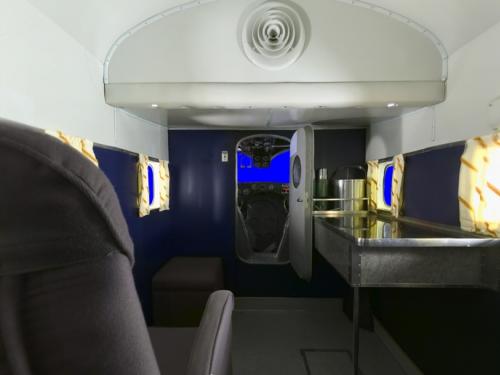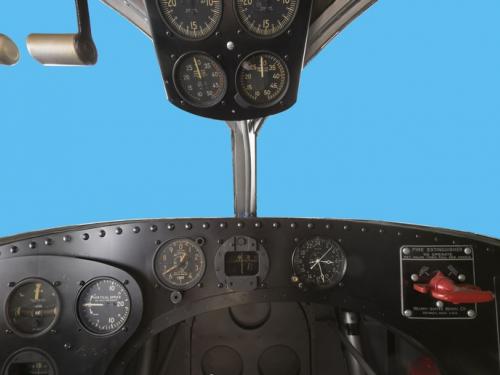Affectionately nicknamed "Goose," the G-21 was Grumman’s first monoplane to fly, its first twin-engined aircraft, and its first aircraft to enter commercial airline service. This remarkably versatile amphibian has served for over fifty years in a variety of roles that have confirmed the strength and durability of its original design.
The inspiration for the G-21 came from a syndicate of ten wealthy New York businessmen and aviators led by Wilton Lloyd-Smith who were seeking a replacement for the Loening Air Yacht they used to commute from their Long Island homes to their offices in Manhattan. In 1936 they approached Grover Loening, who declined but suggested that the syndicate contact the Grumman Aircraft Engineering Corporation, for which Loening consulted and which he had helped finance. Leroy Grumman accepted and immediately went to work with designer and company cofounder William Schwendler, as well as hydrodynamicist Ralston Stalb to build the new G-21 amphibian air yacht.’
The outline of the new design emerged quickly, revealing a stubby yet graceful aircraft. Constructed of 24ST AlcIad aluminum, the G-21 was an all-metal, high-winged monoplane powered by two 450-horsepower Pratt and Whitney Wasp Jr. nine-cylinder, air-cooled radial engines mounted on the leading edge of the high-set wings. The deep fuselage served also as a hull and was equipped with hand-cranked retractable landing gear. Inside the cabin was room for four to six passengers and a flight crew of two. Depending on the level of comfort desired by the individual customer, the G-21 could be fitted with a galley and a lavatory. Floats were suspended beneath each wing and a conventional cruciform tail section installed.
On May 29, 1937, the G-21 completed its first test flight, piloted by Robert L. Hall and Bud Gillies from Grumman’s Bethpage, New York, factory. Flight trials went smoothly and after a lengthening of the hull step to improve the aircraft’s performance on the water, the aircraft was readied for production. The performance of the G-21 was praiseworthy for its time and rivaled commercial airliners in service. With a cruising speed of 290 kilometers per hour (180 miles per hour), the G-21 possessed a range of 1,300 kilometers (800 miles).
On July 3, just five weeks after its maiden fright, the first of twelve G-21s ordered was delivered to its initial customers, Wilton Lloyd-Smith and department store heir Marshall Field Ill. Soon other wealthy owners were enjoying the exemplary flight characteristics and handling of the G-21 Goose. Among those customers were financiers Henry H. Morgan and E. Roland Harriman, C. W. Deeds of United Aircraft, Colonel McCormick of the Chicago Tribune, Boris Sergievsky, test pilot for Sikorsky Aircraft, and Britain’s Lord Beaverbrook. In addition, two were purchased by Asiatic Petroleum. Soon these aircraft were modified to G-21A standards with Wasp Jr. SB-2 engines, an increase in certificated gross weight from 7,500 to 8,000 pounds, and a slightly modified hull to reduce water spray.
The popularity of the G-21 spread as its versatility became well-known throughout the aviation community. Soon orders came in to Grumman from airlines, the military, and foreign customers, impressed by the G-21 ‘s potential. Lloyd Aereo Boliviano (LAB) was the first airline to purchase the G-21 but did not put it into service. KNILM, the Dutch East Indies subsidiary of KLM, acquired two G-21’s and operated them from 1940 until early 1942 when the last one was shot down by the invading Japanese. The coming of World War II prevented the adoption of the Goose on a wider scale by airlines until after the cessation of hostilities.
In 1938, the Royal Canadian Air Force was the first military service to recognize the abilities of the Goose when it ordered one in June of that year, followed soon by orders from the U.S. Army and Navy, as well as the Peruvian Air Force and the Portuguese Navy. During World War II, the Army was the first to order a substantial quantity, operating 26 as OA-9s and OA-13s. The U.S. Navy and Coast Guard operated 169 "Gooses" designated as JRFs in utility, transport, and antisubmarine duty. In total, the air forces and navies of eleven nations have flown the Goose. France flew at least fifteen in combat in Indochina where several JRFs were armed with bombs and machine guns. A total of 345 G-21s were produced by October 1945 when production ended.
While most of the G-21s were quickly phased out of military service after World War II, the Goose renewed its career as an airliner in earnest. Uniquely adapted for travel in virtually any environment, the Goose saw widespread service with small airlines in the Caribbean, California, and Alaska. Among those flying the G-21 were Reeve Aleutian Airways, Alaska Coastal Airlines, Chalk’s Flying Service, and Mackey Airlines. Antilles Air Boats was particularly noted for flying the Goose around the Caribbean from their base in St. Croix in the Virgin lslands. Avalon Air Transport (later Catalina Airlines) competed for a while with Catalina Seaplanes, connecting southern California with Catalina Island.
The Goose still flies today, in its original form and also modified with turboprop engines for increased performance. For over fifty years the rugged and versatile G-21 has performed its daily tasks providing much needed service carrying passengers and freight throughout the world.
The Grumman G-21A, c/n 1048, in the National Aeronautical Collection of the National Air and Space Museum was built in 1938 for the Venezuela Oil Development Branch of the Asiatic Petroleum Company. It was delivered on December 10 without luxury appointments but with special cactus-proof tires for operation in remote areas. It was later sold and flown in Ecuador until 1951 when it was returned to Grumman, refurbished with soundproofing and a camera door, and repainted. In 1954 this aircraft was acquired by Chalk’s Flying Service and flown out of Miami, Florida, to the Bahamas. On February 22, 1977, it was acquired by Catalina Airlines. In December 1982, the aircraft was transferred to Warbirds West and eventually acquired by the Naval Aviation Museum, which in turn transferred title of the aircraft to the National Air and Space Museum on June 30, 1983. The aircraft was then restored by Buehler Aviation Research of Fort Lauderdale, Florida, and placed on display in the Hall of Air Transportation in 1989. The aircraft moved to the Steven F. Udvar-Hazy Center in December, 2003.

